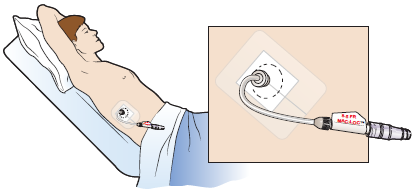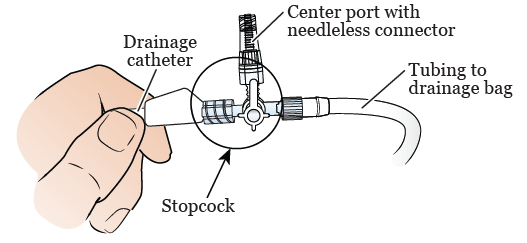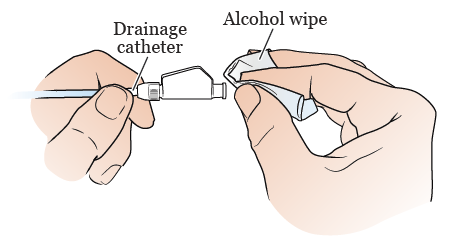This information explains how to do a capping trial on your biliary (BIH-lee-AYR-ee) drainage catheter.
About capping trials
Your doctor may want you to do a capping trial on your biliary drainage catheter. This is to make sure your bile ducts are open and bile can flow easily through your body.
Bile is a fluid made by your liver. It helps you digest (break down) food. Bile flows from your liver through your bile ducts and into your small intestine.
Capping your drainage catheter (see Figure 1) helps your bile travel down the catheter into your body. During the capping trial, the bile should flow without leaking and you should not have pain. If you pass the capping trial, you may not need a drainage bag. Your healthcare provider will tell you if you can stop using the drainage bag.

Your nurse may cap your catheter for you while you’re in the hospital. You’ll need to do it yourself when you’re at home.
How to cap your drainage catheter
-
Gather your supplies. You’ll need:
- An alcohol wipe
- A needleless connector
- A towel
- Put a towel under your workspace to keep the surface clean.
- Disconnect the stopcock from your drainage catheter (see Figure 2).

-
Clean the end of your drainage catheter with an alcohol wipe for 15 seconds (see Figure 3). Then let it dry fully.

Figure 3. Cleaning the end of your drainage catheter - Connect the needleless connector to the end of your drainage catheter (see Figure 4).

Remember to flush your catheter on the same schedule as you did before capping the catheter. You do not need to take the needleless connector off when flushing your catheter.
To flush your catheter, clean the needleless connector with an alcohol wipe for 15 seconds. Let it dry fully. Twist the syringe to attach it to the needleless connector. Then flush through it.
Remember to change the needleless connector every 7 days, or sooner if it gets dirty.
What to do while your catheter is capped
If you have a capped biliary drainage catheter, watch out for these symptoms:
- Leaking around your catheter insertion site. The insertion site is where the catheter goes into your body.
- A temperature higher than 100.4 °F (38 °C) or chills.
- Pain, often in your abdomen (belly) around your catheter insertion site.
These symptoms can happen any time after your catheter has been capped. If you have any of these symptoms, call Interventional Radiology to let us know.
Then, uncap your catheter. To do this:
- Take the needleless connector off your catheter.
- Clean your catheter with an alcohol wipe for 15 seconds. Then let it dry fully.
- Reconnect your catheter to a new drainage bag.
Do not put the cap back on your catheter without calling Interventional Radiology first.
Your symptoms should get better within 30 to 45 minutes. If they don’t, call Interventional Radiology for instructions on what to do next.
Contact information
If you have any questions or concerns, call your doctor in Interventional Radiology. You can reach them Monday through Friday, from 9 a.m. to 5 p.m. If it’s after , a weekend, or a holiday, call 212-639-2000. Ask to speak to the Interventional Radiology fellow on call.